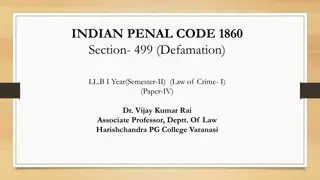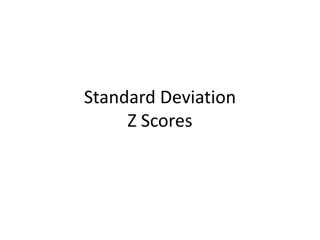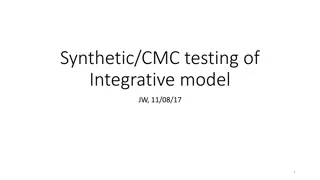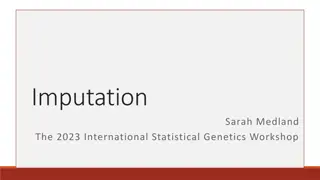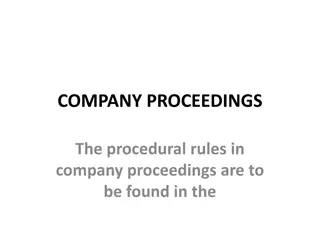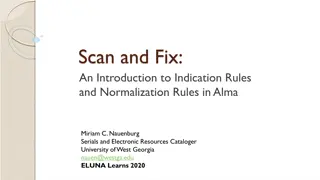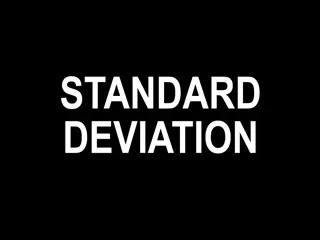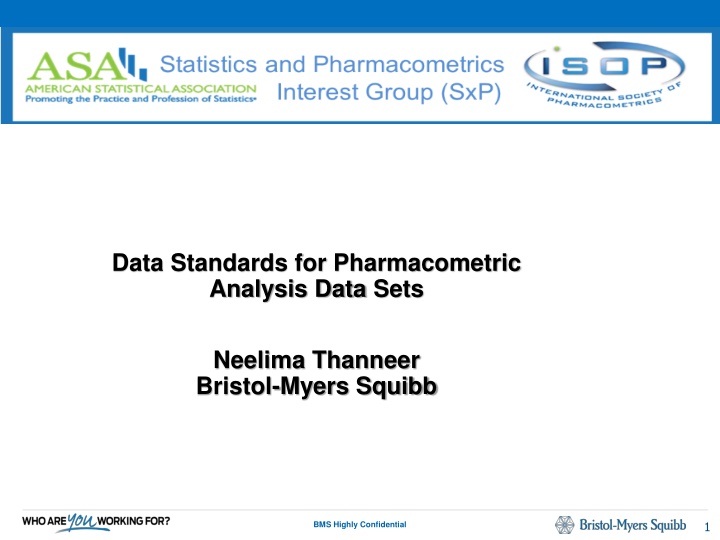
Standard Rules for Imputation in Pharmacometric Analysis
The standards and rules for imputation in pharmacometric analysis data sets include guidelines for handling missing dose date/time information, infusion duration imputation, and designing CRFs to capture relevant data. Imputations should be minimized but may be necessary for Population PK datasets where complete dosing history is often unavailable in the source data. The rules cover scenarios such as imputing dose clock times and infusion durations based on available information. Consistent CRF design is highlighted as crucial for accurate pharmacometric analysis.
Download Presentation

Please find below an Image/Link to download the presentation.
The content on the website is provided AS IS for your information and personal use only. It may not be sold, licensed, or shared on other websites without obtaining consent from the author. If you encounter any issues during the download, it is possible that the publisher has removed the file from their server.
You are allowed to download the files provided on this website for personal or commercial use, subject to the condition that they are used lawfully. All files are the property of their respective owners.
The content on the website is provided AS IS for your information and personal use only. It may not be sold, licensed, or shared on other websites without obtaining consent from the author.
E N D
Presentation Transcript
Data Standards for Pharmacometric Analysis Data Sets Neelima Thanneer Bristol-Myers Squibb 1 BMS Highly Confidential
Source data issues and Standard Rules for Imputation As far as possible imputations should be avoided, but they may be necessary particularly for Population PK datasets as complete dosing history is generally not available in source data. Dose date/time imputation typically occurs in below scenarios: IV dosing where every dose date, time should be recorded Oral doses where interval dosing is recorded 2 BMS Highly Confidential
Standard Rules for Imputation Dose clock time imputation for CRF designs where every single dose date and time is captured If a dose date is available but time is missing: If a trough sample was taken on the same day, use the trough time as the dose time (if IV use start time of infusion). One can add 5 min If no troughs were taken, use the previous dose time. For BID/TID adjust the imputation based on frequency. If the first dose time is missing then impute using day 1 lab time or impute based on post first dose sample time. For BID/TID adjust the imputation based on frequency. The imputed clock time records should be flagged Account for missing doses/dose interruptions based on the number of tablets or comment in text like variable 3 BMS Highly Confidential
Standard Rules for Imputation Infusion Duration Imputation If infusion stop time is available but infusion start time is missing, the protocol defined duration (e.g. 1 hour or 30 min) is used to determine the start of infusion and vice versa if stop time is not available. If both infusion start and stop times are missing on day 1, pre- dose sample time or end of infusion sample time is used along with nominal infusion duration to determine the start of infusion time The imputed date/time records should be flagged 4 BMS Highly Confidential
Standard Rules for Imputation When CRF is designed to capture interval doses with start and stop dates recorded and only dose times relative to PK are recorded Variables ADDL and II are derived to capture the not recorded doses ADDL: Number of additional doses exactly like the current one II: Interdose Interval If the dose time relative to PK samples are not recorded then impute using the IV imputation rules 5 BMS Highly Confidential
Influencing CRF Design CRF s are not consistently designed to capture the information need for Pharmacometric analysis For BID and TID CRF should capture the prior 2 and 3 dose times relative to PK. First dose time should be collected Dose interuptions for BID and TID doses should indicate which doses are missing 6 BMS Highly Confidential
Population PK Data Standards Initiative Sponsored by International Society of Pharmacometrics (ISoP) Group of around 20 enthusiastic pharmacometricians and data programmers has come together at the beginning of 2016 to address the outlined situation and work on its improvement. With the sponsorship of ISoP, the group envisions the development of PPK data standards for interchange and analysis. Some of the benefits of the work will directly reflect on improved: Consistency and efficiency in pharmacometric datasets Quality (fewer errors, enabling development of open-source tools for automatic data checking) Enabling development of open-source tools for automatic graphical exploration Regulatory compliance and audit readiness (enabling development of open-source tools for data submission) 7 BMS Highly Confidential
Objective: Standardized datasets used directly by analysis software Source data Standardized dataset SDTM Population PK standard dataset Analysis ADaM NONMEM, Monolix, R, Stan, Julia, etc can use standardized datasets directly Already the case for R and some other tools Common variable names Common structure Will always look the same Suitable for collaboration Typically SAS datasets Radivojevic, et al. ACoP 2016 8 BMS Highly Confidential
What we have done Draft standard for input data Source dataset and variable name Required input from the pharmacometrician? Classified by information group Controlled terminology CDISC naming conventions and length requirements Imputation and derivation guidance General comments 9 BMS Highly Confidential
What we have done Current status Path to CDISC data standards for pharmacometrics hand-over of solid draft data structure review by CDISC teams and feasibility assessment implementation guide Preparing a Perspectives article to outline our thinking and objectives 10 BMS Highly Confidential
Next steps Scripts for further conversion into tool dialects Once the standard is established, capture the deliverable in a White paper Longer term: Start expanding to PKPD data Develop and publish automation scripts For this initiative to succeed, it must make things faster, easier and more efficient For modelers For programmers For any other stakeholders 11 BMS Highly Confidential

